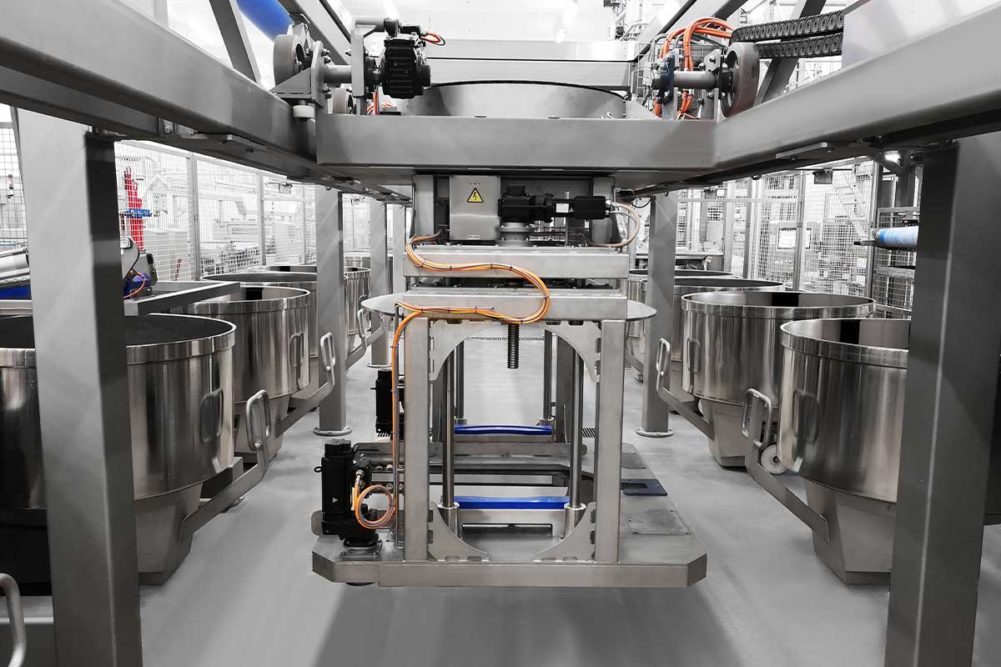Bakers are mixing it up when it comes to automating mixing, but exploring different technologies can be challenging, especially for legacy bakeries that are comfortable with the processes they’ve been using for decades.
That’s why bakeries need a mixing system designed to adapt to their existing needs while ensuring that the operation provides flexibility, suggested Melanie Gay, marketing manager, VMI.
“Configure your system depending on the dough flow required,” she said. “The number and type of mixers and bowl capacity to be integrated into the system will vary depending on the flow needed.”
Moreover, she recommended choosing technology according to a bakery’s recipes.
“Depending on the type of dough, the installation can integrate planetary mixers, fork mixers or batch mixers with a single or double tool to achieve the required texture, hydration, elasticity and more,” Ms. Gay said.
Each style of mixer has its pros and cons, and the debate among them is almost as personal as New York vs. Chicago-style pizza. Often for bakers, it’s more about preference and product characteristics than comparison of technologies.
“Because the continuous mixer discharges dough at a constant rate equal to the usage rate, the dough is the same age when further processed,” said Jim Warren, vice president of Exact Mixing, Reading Bakery Systems, and proponent of continuous mixing. “Batch mixed dough, on the other hand, varies in floor time consistently, and the variation is equal to the time between mixer discharges. For some processes, this is extremely critical to finished product characteristics. For other processes, this makes no difference.”
In other cases, it all depends on the final product, whether it’s cookies, crackers or an artisan bread with a long fermentation time.
“Over the years, I’ve become as big of a proponent of continuous mixing as I am of batch,” said Terry Bartsch, executive product manager, AMF Fusion, an AMF Bakery Systems brand. “There are absolutely certain high throughput applications where customers should be looking at continuous mixing, and I will tell those bakers when their process lends itself to continuous mixing.”
Both initial price and total cost of ownership also vary by mixer style, size, speed, output, options and related equipment such as preferment systems, automated trough handling, dough chunkers and other product handling technology that might be necessary for automating.
For instance, Ronald Falkenberg, sales director for USA and Canada, Diosna, noted the Wendel mixer’s distinct design puts more energy into the dough while generating less heat. He said the Wendel’s mixing time is about 6 minutes, which is less than others, but the initial investment can be much higher.
Diosna offers a bottom discharge from the mixer, which can save labor or an investment in a bowl lift by having the dough automatically conveyed up to the divider, hopper or another part of the makeup area.
Escher Mixer, a Middleby Bakery company, also provides a bottom discharge with its MDW system where the dough is unloaded onto a conveyor. Alessandro Cosaro, Escher’s founder, said the compact system can feature two or more series of mixers that feed the dough directly into the production lines, while an optional extension offers a system for letting the dough rest.
When it comes to speed, Ms. Gay said, bakers should tailor their production rate to their formulas.
“The type of recipe will determine how much passage time is required,” she said. “Small batches are preferred if there is no resting time, and a quick production rate is required. As a result, there will be more mixers on the line. Larger batches are preferred If the recipe requires resting time or if a fast pace is not necessary, allowing you to have fewer pieces of equipment on the line and optimize space.”
The bakery may be initially hesitant about the price, but in the end, they need only one mixer instead of two of them when automating,” she said.
A sourdough bakery, for example, often needs a system that integrates several rest and fermentation phases.
“On the other hand, a configuration for a dough that does not need to rise will have a fast pace and very little rest between kneading and dough transfer,” Ms. Gay observed.
She added that automated mixing systems can integrate dosing, mixing phases, resting periods, fermentation systems and more. Automating the front end of a production line often includes much more than the mixer.
“You can include cleaning stations, which are especially useful if you produce recipes with allergens to avoid cross contamination,” Ms. Gay said. “If you have trimmings or scrap dough, you can integrate a scrap dough dosing station to limit raw material loss and save money.
“With an automated mixing system, you can weigh your options and make decisions based on your priorities such as speed, cleanliness, adaptability, installation area and the degree of line automation,” she added. “If product quality is your top priority, you can make the right choices to reflect that in your production.”
This article is an excerpt from the May 2023 issue of Baking & Snack. To read the entire feature on Mixing, click here.






